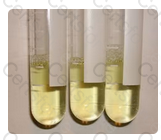CAMP is the correct answer because the case is typical of Streptococcus agalactiae(Group B strep). The main presumptive identification test is CAMP. Bile solubility is positive for Streptococcus pneumonia. Coagulase would be positive for Staphylococcus aureus. PYR is positive for Streptococcus pyogenes (Group A strep) which is ruled out by the resistance to bacitracin.
Microbiology
Spinal fluid cultures on a 3-day-old infant revealed beta-hemolytic, Gram-positive cocci occurring in pairs and chains. The organism was catalase-negative and bile esculin-negative. Resistance to 0.04 U disk of bacitracin was noted. The other test necessary to identify this organism is a positive test by:
Clostridium difficile is a gram-positive, anaerobic, spore-forming bacillus that produces a strong toxin. C difficile is a common cause of antibiotic-associated diarrhea and pseudomembranous colitis.
Microbiology
A recto-sigmoidoscopy revealed pseudomembranes in a patient with severe diarrhea following prolonged treatment with ampicillin. Which of the following organisms is MOST likely to be isolated?
A slow, progressive drift of values away from the mean is called a trend. Trends occur when a particular analyte value slowly and progressively changes in one direction from one run to the next. Monitoring data for trends is part of good laboratory practice and is one indicator of many that helps laboratorians determine whether the measurement system is fucntioning appropriately.
A slow, progressive drift of values away from the mean is called a:
C. immitis is a dimorphic fungus which can be isolated from sputum specimens of infected individuals. When grown on Sabouraud's agar at 25o it grows as a mold with white aerial mycelium in about 3 to 5 days. C. immitis is known to produce arthroconidia which are "barrel-shaped" after 1 to 2 weeks of growth.
Within three days at 28 ºC a sputum specimen placed on Sabouraud's dextrose agar with chloramphenicol and cycloheximide produced moist, grayish growth, with a white aerial mycelium, the organism is MOST likely:
The division of Department of Health and Human Services (DHHS) responsible for protecting public health by ensuring the safety and efficacy of foods, drugs, biological products, medical devices, and cosmetics is:
Serum calcitonin is normally produced by the C cells of the thyroid. It functions to reduce serum calcium by inhibiting release of calcium from bone. It is a peptide with a molecular weight of 3400, and has a half life of approximately 12 minutes. It is characteristically elevated in medullary carcinoma of the thyroid. Since medullary carcinoma often occurs as an autosomal disorder, family members of patients with this condition should be screened for serum calcitonin.
Serum calcitonin is typically elevated in which of the following conditions:
These are tyrosine crystals

Urinalysis & Other Body Fluids
True or false? Cystine crystals are present on this slide.
Any oxidase-positive organism can be excluded from the Enterobacteriaceae. The other characteristics are as a rule present in these organisms.
Which of the following is not true about members of the Enterobacteriaceae:
Where can one find guidance on the minimum performance standards for clinical laboratories?
L/S ratio <2.0 indicates an increased risk of respiratory distress syndrome (RDS) at delivery. L/S ratio <1.5 indicates a very high risk of developing RDS.
Which of the following statements regarding the L/S ratio is TRUE?
The correct answer is highlighted below
A ratio of 2:1 or greater usually indicates adequate pulmonary surfactant to prevent respiratory distress syndrome (RDS)
A ratio of 1.5:1 indicates fetal lung maturity in pregnancies associated with diabetes mellitus.
Sphingomyelin levels increase during the 3rd trimester causing the L/S ratio to fall slightly during the last two weeks of gestation.
A phosphatidylglycerol (PG) spot indicates the presence of meconium in the amniotic fluid
Lecithin is in direct ratio with sphingomyelin
Heparin contamination is characterized by an elevation in the aPTT test and can also cause an increased PT test as well. Reptilase time tests are used to elimate the effects of heparin contamination as the reagents and method are resistant to the effects of antithrombin III, unlike the PT and aPTT tests. Therefore, it would be expected that a patient sample containing pre-analytical heparin contamination will show an increased aPTT (and sometimes PT as well) while showing a normal reptilase time.
A specimen drawn from an indwelling catheter that was contaminated by heparin would be indicated by:
When an antigen comes in contact with the skin, the antigen is processed by cells in the epidermis and come in contact with T lymphocytes. T lymphocytes recognize the antigen as foreign and circulate through the bloodstream back to the epidermis and produce an inflammatory response to eliminate the antigen, but this immune response can produce a characteristic rash in the skin called contact dermititis.
Contact dermatitis is mediated by:
The term that is used to describe the color in these tubes of CSF is "xanthochromia." Xanthochromia is an abnormal color, usually yellow, orange, or pink, in the supernatant of the CSF sample. It may indicate that a subarachnoid hemorrhage (SAH) has occurred.

Jaundice and icterus both describe a yellowing of the skin, mucous membranes, and eyes. Blood plasma/serum that is deep yellow is also described as icteric.
What term is used to describe the color in these tubes of cerebrospinal fluid (CSF)?
Flow cytometry employs a combination of fluorescent antibody tagging of cells and analysis with laser light scatter.
What principle(s) of flow cytometry are employed when performing immunophenotyping:
The ratio of blood to anticoagulant in a light blue stopper tube is:
Which of the following is NOT part of the stand or framework of the microscope?